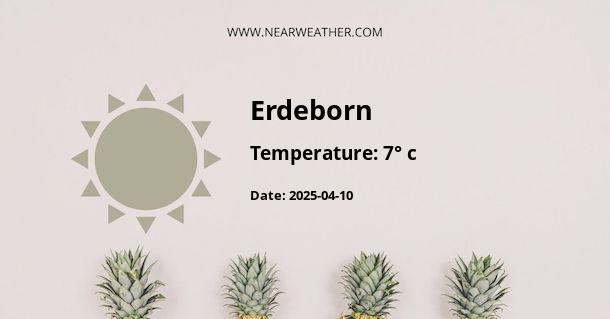Understanding Erdeborn, Germany: A Climate and Weather Perspective
Geographical Context
Erdeborn is a locality situated in the heart of Germany. Its geographical position profoundly influences its climate, resulting in a temperate seasonal climate typical of the Northern European Plain. Before delving into the climate specifics, it's important to understand how Erdeborn's coordinates, elevation, and proximity to natural formations like rivers and forests might affect its weather patterns.
Climate Analysis
The Köppen climate classification categorizes the climate in Erdeborn as Cfb, which stands for a temperate oceanic climate. This classification indicates cool, often overcast winters and mild to warm summers with a fair amount of precipitation distributed evenly throughout the year.
Temperature Overview
| Season | Average Temperature Range |
|---|---|
| Spring | 4°C to 15°C (39.2°F to 59°F) |
| Summer | 13°C to 24°C (55.4°F to 75.2°F) |
| Fall | 6°C to 14°C (42.8°F to 57.2°F) |
| Winter | -2°C to 4°C (28.4°F to 39.2°F) |
The temperature ranges provided are generalized averages for Erdeborn and can fluctuate due to changing climatic patterns.
Precipitation and Humidity
- Erdeborn receives a consistent level of precipitation year-round.
- Monthly rainfall averages can range from 40 mm in the dryer months to 60 mm during the wetter periods.
- Snowfall is common in the winter months, typically from December to February.
- The humidity levels are moderate to high throughout the year, due to the maritime influence.
Wind and Storm Patterns
Prevailing westerly winds bring in moisture from the Atlantic Ocean, which can lead to overcast and rainy days. Storms are more frequent during the fall and winter months, though severe weather like tornadoes is exceedingly rare in this region.
Monthly Climate Breakdown
Seasonal variations in Erdeborn offer distinct weather conditions that can impact travel plans, agricultural activities, and energy consumption. Let's provide a more detailed monthly breakdown:
January
January is the coldest month, with average lows reaching -2°C (28.4°F) and snow is quite common. The days are typically short, with limited sunlight hours.
February
While still cold, February starts to see the temperatures slowly rise, and the precipitation remains with snow and rain mixtures.
March
In March, the onset of spring is noticeable with temperatures ranging from 1°C to 8°C (33.8°F to 46.4°F) and daylight hours increase.
April
April sees a considerable warm-up with temperatures averaging between 4°C to 15°C (39.2°F to 59°F), but with unpredictable rain showers.
May
May is when the weather becomes quite pleasant with averages of 8°C to 20°C (46.4°F to 68°F), and nature is in full bloom.
June
June is the beginning of the summer season with longer days and temperatures ranging from 13°C to 24°C (55.4°F to 75.2°F).
July
July is typically the warmest month, with similar temperature ranges to June but with more stable weather patterns.
August
August maintains the summer warmth, but thunderstorms are more common due to increased humidity.
September
September marks the transition to autumn, with temperatures cooling slightly to averages between 10°C to 20°C (50°F to 68°F).
October
Autumn is in full swing in October with temperatures dropping further to 6°C to 14°C (42.8°F to 57.2°F) and the leaves changing color.
November
November is noticeably cooler and wetter, as temperatures typically hover between 2°C to 8°C (35.6°F to 46.4°F).
December
December is the advent of winter with temperatures similar to November but with increased chances of snowfall as the month progresses.
Climate Impacts on Lifestyle and Economy
The weather in Erdeborn has distinct implications for the lifestyle of its inhabitants and the local economy. The consistent rainfall supports agriculture, particularly in the rich soils of the region that sustain various crops and livestock. On the other hand, the cold winters necessitate proper heating systems and can disrupt transportation when snowfall is heavy.
Looking Forward: Climate Projections
Climate change is having a visible impact on Erdeborn, as it is on the rest of the world. According to recent studies, the region can expect higher average temperatures, altered precipitation patterns, and possibly more extreme weather events. Local government and community efforts are in place to adapt to these changes, focusing on sustainable practices and disaster preparedness.
Adaptation and Sustainability Efforts
- Increasing green spaces to help absorb rainfall and reduce runoff.
- Implementing renewable energy sources to decrease reliance on fossil fuels.
- Enhancing public transportation to reduce carbon emissions.
- Promoting sustainable agriculture to ensure food security.
To conclude, Erdeborn's climate and weather are characterized by their temperate nature, with a reliable amount of rainfall and moderate extremes in temperatures. The shift of seasons brings a diverse range of weather patterns that shape the everyday life of its residents and the natural environment. As global climate trends continue to evolve, Erdeborn's community is invested in adapting to these changes while maintaining the region's resilience and sustainability.
A - Erdeborn's Latitude is 51.483330 & Longitude is 11.633330.
A - Weather in Erdeborn is 17° today.
A - Climate Conditions in Erdeborn shows scattered clouds today.
A - Humidity in Erdeborn is 68% today.
A - Wind speed in Erdeborn is 3.89 km/h, flowing at 11° wind direction. today.
